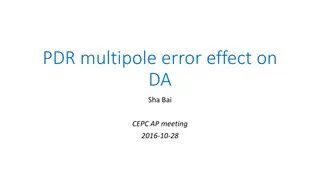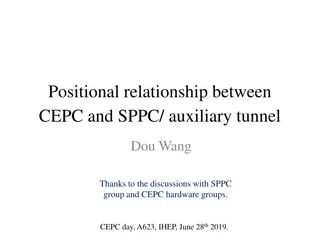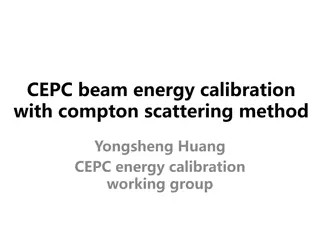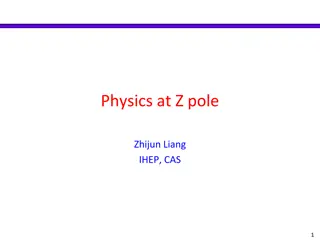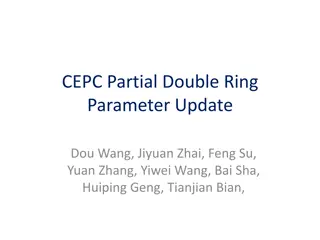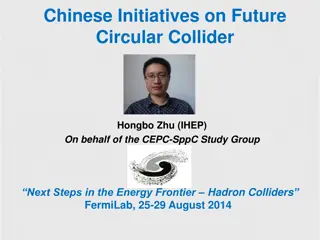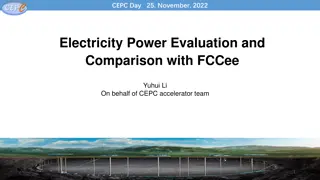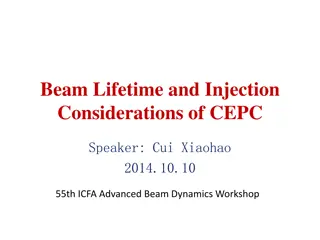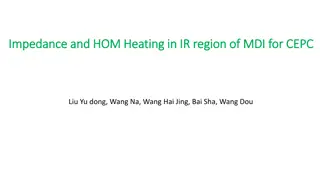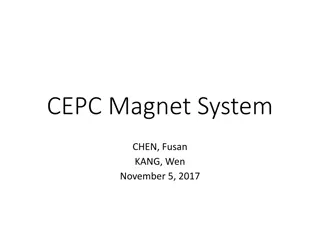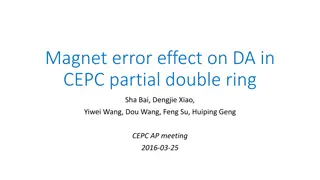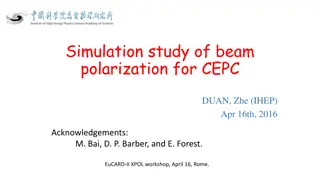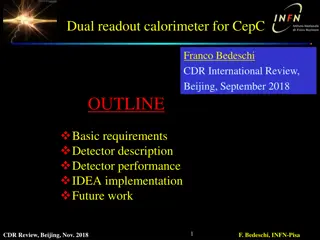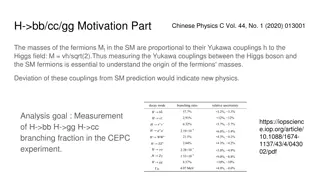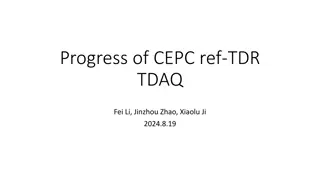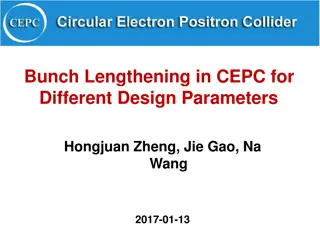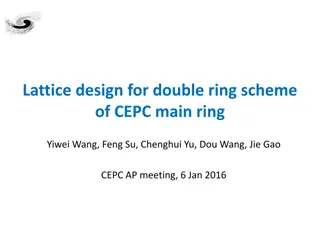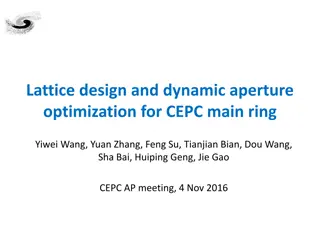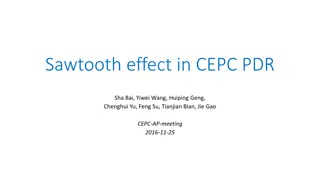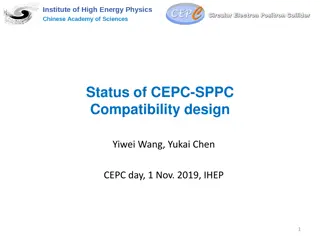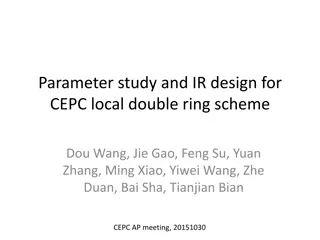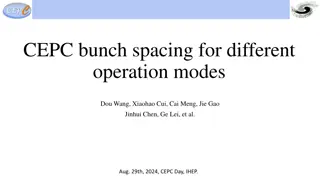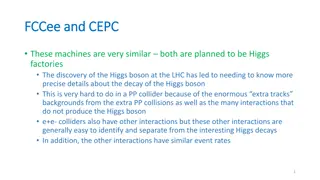Analysis of Multipole Error Effects on Beam Dynamics in CEPC Accelerator
The content discusses the impact of multipole errors on the beam dynamics at the CEPC Accelerator, focusing on sources of error, measurements, and potential effects on the beam. The analysis includes different types of multipole errors, their sources, and the resulting changes in tune and emittance
4 views • 11 slides
Tasks of Alignment and Installation in CEPC Project
Tasks involved in the alignment and installation optimization of components in the Circular Electron Positron Collider (CEPC) project include control network construction, component installation, smooth alignment, and addressing any arising problems. The process is crucial for the successful operati
2 views • 19 slides
Design Considerations for CEPC Double Ring Scheme
The interaction region design for the partial double ring scheme at CEPC involves primary parameters, ARC lattice structures, tune shift effects, chromaticity corrections, and optimization strategies for 3rd order chromaticity. The integration of ARC and IR components aims to enhance chromaticity co
0 views • 9 slides
Positional Relationship Between CEPC and SPPC for Accelerator Physics
The positional relationship between the Circular Electron-Positron Collider (CEPC) and the Super Proton-Proton Collider (SPPC) involves careful considerations such as bypass tunnels, compatibility for future e-P collision programs, and shielding in the tunnel. Various scenarios are discussed regardi
0 views • 8 slides
Beam Energy Calibration with Compton Scattering Method
The CEPC beam energy calibration with Compton scattering method led by Yongsheng Huang and the CEPC energy calibration working group involves collaborations with various institutions and organizations. The project includes detailed physics requirements, system designs, and implementation plans for b
0 views • 14 slides
Advancements in Electroweak Precision Physics at Z Pole in CEPC
CEPC is making remarkable progress in electroweak precision physics at the Z pole, aiming for significant improvements in luminosity and precision measurements. Research on W/Z physics, branching ratios, gluon splitting, systematics reduction, and detector enhancements are key focus areas. CEPC expe
1 views • 14 slides
CEPC Partial Double Ring Parameter Update
The CEPC Partial Double Ring Layout features advantages like accommodating more bunches at Z/W energy, reducing AC power with crab waist collision, and unique machine constraints based on given parameters. The provided parameter choices and updates aim to optimize beam-beam effects, emittance growth
0 views • 14 slides
Advancements in Chinese High-Energy Physics Research
Initiatives like the CEPC-SppC Study Group and Circular Electron Positron Collider (CEPC) showcase China's commitment to pioneering future collider projects. With a focus on the energy frontier, developments such as the upgrade to a 50-70 TeV pp collider indicate significant progress in the field. T
0 views • 32 slides
Comparison of Electricity Power Systems Between CEPC and FCCee
The evaluation and comparison of electricity power systems between the CEPC and FCCee accelerators reveal the power breakdowns, RF power consumption, magnet power supply, and overall power usage. Differences in power consumption for various components such as RF, magnets, and vacuum systems are high
1 views • 19 slides
Beam Lifetime and Injection Considerations at CEPC
Delve into the intricacies of beam lifetime and injection considerations at the CEPC, exploring topics such as beam-gas scattering, quantum lifetime, Touschek lifetime, and injection modes. Discover the crucial factors affecting beam stability and injection efficiency in particle accelerators.
0 views • 20 slides
Impedance and HOM Heating in IR Region of MDI for CEPC
This study explores impedance and Higher Order Mode (HOM) heating in the Infrared (IR) region of MDI for the Circular Electron Positron Collider (CEPC). It discusses beam parameters, structure, layout of the vacuum chamber, and power deposition for different IR pipe models in detail. Additionally, i
0 views • 33 slides
CEPC Collider Magnet System Overview
The CEPC collider magnet system comprises dual aperture dipole, dual aperture quadrupole, sextupole, and booster magnet designs. These magnets cover a significant portion of the 100km ring, addressing considerations such as manufacturing cost, power consumption, and field quality. The design focuses
2 views • 24 slides
Analysis of Magnet Errors in CEPC and LEP: Impact on Accelerator Performance
Investigating the effects of magnet errors on the Double Arc (DA) in the CEPC partial double ring, including alignment parameters, field errors, and their consequences on the orbit, tune, and stability of the beam. The study explores quadrupole, bending magnet, and sextupole field errors, highlighti
0 views • 13 slides
Radiative Polarization Techniques in CEPC for Precision Measurements of Z-Pole Mass
Prof. Jie Gao led discussions on the CEPC polarization program, focusing on obtaining transverse and longitudinal polarizations. The use of special wigglers to enhance the polarizing effect of the magnetic field was highlighted, reducing the time needed for radiative self-polarization. Strategies to
1 views • 22 slides
Beam Polarization Simulation Study for CEPC
Simulation study on beam polarization for the Circular Electron Positron Collider (CEPC) using the PTC Poly- morphic Tracking Code. The study includes orbital and spin tracking, equilibrium polarization calculation, and Monte-Carlo simulation of depolarization rate. Comparison with other Monte-Carlo
2 views • 20 slides
Dual-Readout Calorimeter for CepC: Overview and Key Features
The dual-readout calorimeter for CepC, as discussed in the International Review in Beijing, September 2018, is designed to optimize electromagnetic, hadronic, and jet resolution. With features like large sampling fraction for good EM resolution, event-by-event correction for EM fluctuations, and int
1 views • 22 slides
Measurement of Higgs Boson Yukawa Couplings and Branching Fractions in CEPC Experiment
The study focuses on measuring the Yukawa couplings between the Higgs boson and Standard Model fermions to understand fermions' masses and potential deviations indicating new physics. The analysis aims to measure Higgs decays to bb, cc, and gg at the CEPC experiment through event selection criteria,
1 views • 8 slides
Physics Workshop in November: Topics, Analysis, and Collaboration
Workshop in November will feature parallel sections on physics and simulations under detector section, with a focus on HL-LHC and CEPC challenges, EFT, new physics perspectives, and fast simulation for CEPC. A variety of topics including combination and kappa analysis, EFT implications, simulations,
0 views • 5 slides
Updates on CEPC Project Progress and Meetings for August 2024
This update covers the progress of CEPC project with a focus on the Technical Design Report (TDR), including TDAQ developments by Fei Li, Jinzhou Zhao, and Xiaolu Ji. It outlines periodic meetings, work plans, and group activities for August 2024. The Build Working Group's activity involving simulat
1 views • 4 slides
Analysis of Bunch Lengthening in CEPC for Different Design Parameters
This study explores bunch lengthening in the Circular Electron Positron Collider (CEPC) for various design parameters, analyzing a 54 km design scheme, a 61 km design scheme, and a 100 km design scheme. The analysis includes the theoretical framework used, equations for bunch lengthening, and conclu
1 views • 15 slides
Preliminary Study of HTS Option for CEPC Detector Magnet
This study explores the use of high-temperature superconductors (HTS) for the CEPC detector magnet, focusing on Bi-2223, Bi-2212, and YBCO conductors. It discusses the properties of each conductor, their suitability for the magnet, and the decision to choose YBCO. The advantages and challenges of ut
0 views • 14 slides
CEPC Main Ring Double Ring Scheme Lattice Design
Lattice design and parameters for the double ring scheme of the Circular Electron Positron Collider (CEPC) main ring discussed at the CEPC AP meeting in January 2016. The outline covers the CEPC parameters for C=100km, including the lattice design and geometry for different regions. Details on energ
0 views • 14 slides
Dynamic Aperture Optimization for CEPC Main Ring
Lattice design and dynamic aperture optimization for the Circular Electron Positron Collider (CEPC) main ring were discussed, focusing on maximizing the dynamic aperture through lattice configurations in the ARC region, interaction region, and partial double ring region. Various strategies such as c
0 views • 14 slides
CEPC RF Power Source Overview
The CEPC RF Power Source involves high-power RF sources for accelerating and stabilizing particles in the Collider system. It includes design elements, efficiency considerations, and operational cost impacts. The transmission system utilizes superconducting cavity technology to meet power demands ef
0 views • 24 slides
CEPC Time of Flight and Outer Tracker with LGAD Updates
Updates on the progress of CEPC's Time of Flight and Outer Tracker with LGAD by Yunyun Fan from IHEP. The information covers sensor design, CEPCSW progress, mechanics design for cooling the ASIC, hit rate estimations for electronics, and backups. Collaboration with Italian colleagues is highlighted
0 views • 7 slides
Parameters and Results for CEPC in 30MW & 50MW
Parameters and results for the Circular Electron Positron Collider (CEPC) operating at 30MW and 50MW including information on the Higgs, W, Z, and ttbar processes. The data covers various aspects such as the number of IPs, circumference, power per beam, bending radius, energy, beam properties, beam-
0 views • 7 slides
CEPC Time of Flight and Outer Tracker Design
Mechanics and electronics design considerations for the CEPC Time of Flight and Outer Tracker, focusing on cooling methods, power distribution, background simulation results, and physics data rate estimations. The content includes conservative estimations of power distribution, module dimensions, hi
0 views • 9 slides
Sawtooth effect in CEPC PDR
Investigates the sawtooth effect in the CEPC project. The study, conducted by PDRSha Bai and colleagues, delves into the complexities of this phenomenon. The paper discusses the findings, implications, and potential applications of the sawtooth effect in the context of the CEPC project. Insightful a
0 views • 13 slides
Sawtooth effect in CEPC PDR
Study on the sawtooth effect within the CEPC project presented by PDRSha Bai, Yiwei Wang, Huiping Geng, Chenghui Yu, Feng Su, Tianjian Bian, and Jie Gao at the CEPC-AP meeting in 2016. The research delves into the characteristics and implications of the sawtooth phenomenon observed in the project's
0 views • 14 slides
Plan for CEPC Software Development in 2020
Software environment requirements include gcc, cmake, boost, ROOT, TensorFlow, and multi-threaded Gaudi. Association relationships in EDM and plans for event navigation are addressed. Porting tracking algorithms from Marlin to CEPCSW is discussed, along with migration algorithms and validation plans
0 views • 11 slides
CEPC Time of Flight and Outer Tracker with LGAD
Power distribution details for the CEPC time of flight and outer tracker system with LGAD technology are provided in the images. The arrangement of the time of flight with strip LGAD barrel, power distribution per channel, ASIC dimensions, and module specifications are described. The power distribut
0 views • 5 slides
Status of CEPC-SPPC Compatibility design
Investigating the compatibility of CEPC and SPPC designs, focusing on tunnel requirements, section lengths, and IP1 & IP3 compatibility. Addressing bend constraints and bypass solutions for optimal integration.
0 views • 10 slides
CEPC magnet error study Summary
In preparation for the CEPC AP meeting on 2015-12-25, an analysis was conducted regarding the magnet errors in the system. The study summarized the findings and implications of these errors, shedding light on potential improvements and areas for further research.
0 views • 16 slides
Introduction to TDAQ Sessions at CEPC Workshop
This session introduces the TDAQ (Trigger and Data Acquisition) aspects at the CEPC Workshop, featuring talks on sub-detectors, data volume, readout implementations, and more. Clear requirements from various detectors are discussed, along with special technologies in pixel readout. Time zone adjustm
0 views • 12 slides
Lattice Design and Dynamic Aperture Optimization for CEPC Main Ring
This presentation explores lattice design and dynamic aperture optimization for the main ring of the Circular Electron Positron Collider (CEPC). It covers the optimization of dynamic aperture, increasing dispersion, beta*, managing chromaticity, and addressing various challenges in achieving optimal
1 views • 22 slides
CEPC Local Double Ring Scheme Parameter Study and IR Design
This study focuses on the parameter study and IR design for the CEPC local double ring scheme. It discusses machine constraints, given parameters, energy acceptance, emittance growth, beam lifetime limitations, effective bunch length, and more. The research aims to optimize the CEPC scheme for enhan
0 views • 16 slides
CEPC Bunch Spacing and Frequency Requirements for High-Energy Collider Operations
The CEPC (Circular Electron Positron Collider) has specific requirements for bunch spacing and frequency in different operation modes to optimize performance. With detailed considerations for injection/extraction chain, bunch spacing from detector J.C. Wang, and frequency choices, the CEPC aims to s
0 views • 22 slides
CEPC Injection System Design and Parameters
Explore the injection system design of the Circular Electron Positron Collider (CEPC) for high luminosity and different injection modes. Key parameters and injection time structures are discussed, along with details on Higgs, W, and Z injection modes, beam characteristics, and collider lifetime cons
0 views • 24 slides
Insights into FCCee and CEPC for High-Energy Physics Studies
Explore the similarities between FCCee and CEPC machines designed as Higgs factories, focusing on the challenges of studying Higgs boson decay and distinguishing interactions. Learn about machine parameters, backgrounds, and Higgs production in these advanced colliders." (313 characters)
0 views • 13 slides
Comparison of CEPC IR Sextupole Magnet Excitation Current
Explore the excitation current differences in CEPC IR sextupole magnets between 2018 and updated CDR parameters, utilizing conventional magnet technology for updated requirements. Details include reduction in magnet bore, pole field, and feasibility considerations.
0 views • 12 slides
